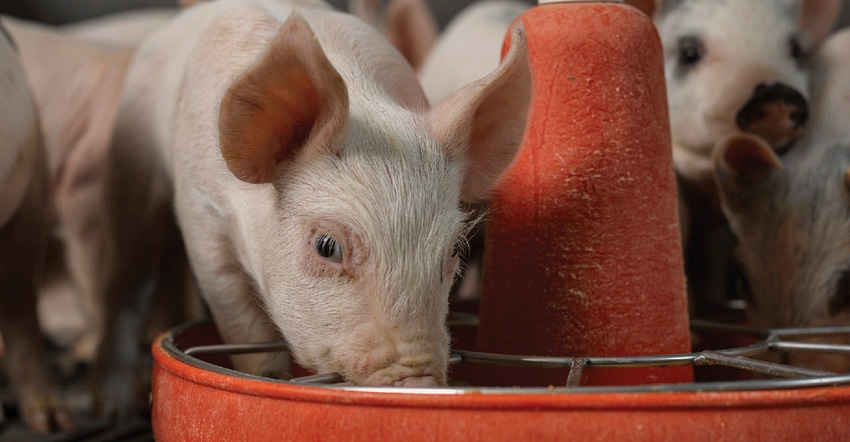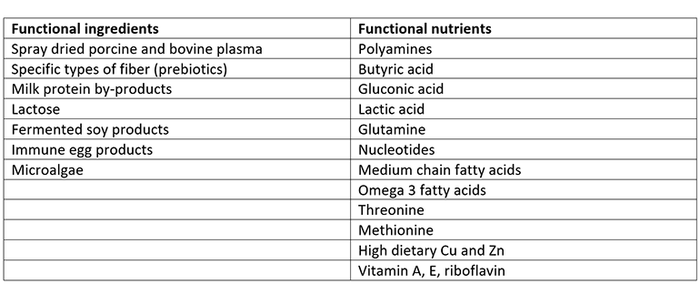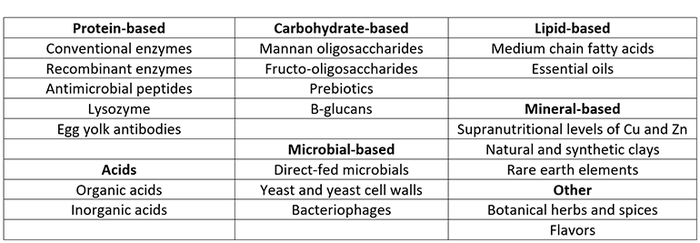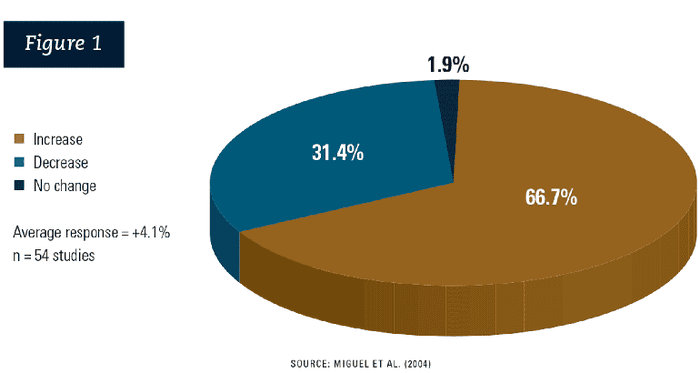Blueprint Issue: Future opportunities may improve the nutritional efficiency and health of pigs.
July 11, 2019

By Jerry Shurson and Pedro Urriola, University of Minnesota
With much discussion and focus on alternatives to antibiotics and the need to improve gut health, maybe it is time to take a step back and reflect on the many components of feed and feeding programs that affect the nutritional efficiency and health of pigs.
Although many feed additives can improve nutrient use and gut health, there are no silver bullets, though some nutritionists consider growth-promoting antibiotics to be the closest thing to it.
As a result, we often compare responses from feeding various feed additives, using antibiotic responses as the standard. Unless the additive has antimicrobial properties, we can’t expect to achieve the same growth performance and health responses because each compound has different modes of action.
Therefore, although it is unlikely that any of the feed additives on the market today will achieve this, they can provide important, cost-effective benefits when used strategically in swine diets if we understand their mode of action.
But before we begin considering the use of feed additives, we need to think about their role and benefits more holistically, because optimizing pig health and performance is extremely challenging and complex.
‘Perfect’ feeding program
Most nutritionists would agree that the first goal of a “perfect” feeding program is to improve profitability.
However, pork production profitability is affected by many factors, including enabling pigs to express their full genetic potential and optimize the conversion of dietary calories and nutrients into high-quality lean meat. This can only be accomplished by formulating farm-specific diets and getting the “right feed to the right pigs at the right time.”
Because everyone involved in the pork industry contributes in some way to the production of high-quality, safe and environmentally sustainable pork, we also have a responsibility to make sure the diets being fed to pigs promote animal well-being, minimize food safety risks, promote public health, meet consumer expectations, and have the least negative impact on the environment as possible.
Major challenges add to the complexity and need to be addressed when designing the perfect feeding program. These include antibiotic resistance, climate change, reducing environmental impact, feed biosecurity and disease challenges that change nutrient requirements and pig well-being.
Antibiotic resistance
One of the major challenges that led to the discontinuation of use of growth promoting antibiotics in swine diets has been a result of the need to reduce the development of bacterial antibiotic resistance and its negative impacts on public health. High dietary levels of copper and zinc have been fed to nursery pigs for many years because of their antimicrobial and growth promoting effects. However, they have also been shown to contribute to the development of antimicrobial resistant bacteria. It is unknown if other feed additives with antimicrobial properties have the ability to do this.
Likewise, use of antibiotics in drinking water or feed for an entire barn of pigs, is an effective way to prevent secondary infections and improve growth performance of pigs during viral infections such as porcine reproductive and respiratory syndrome. Therefore, feeding programs will need to consider additives that can help pigs cope with secondary infections during viral infections.
Climate change
The effects of climate change on weather patterns are projected to increase the frequency of extreme weather events, which will likely increase the prevalence and concentrations of mycotoxins in grain. Mycotoxins continue to be a major global concern in feed ingredients, and it appears that this will only get worse. A recent survey conducted by Biomin in 2017 showed that the percentage of corn samples with detectable levels of DON, zearalenone and fumonisins in North America ranged between about 33 to 74%.
Despite years of researching and trying to deal with this problem, we still have a relatively superficial knowledge of the effects of only a few of the major mycotoxins on pig health and performance. For example, we have observed that feeding diets containing low levels of deoxynivalenol, zearalenone and fumonisins can interact synergistically to decrease growth performance of pigs to a greater extent than what would be expected from each individual mycotoxin. In addition, we need to characterize other lesser known mycotoxins that may be detrimental, understand the interactive effects of co-occurring mycotoxins, as well as the relative toxicity of masked mycotoxins.
Another negative consequence of climate change is the increased frequency and duration of heat stress on animals. Studies have shown that exposure of pigs to 95 degrees Fahrenheit for only two to six hours can significantly compromise the intestinal structure and immune defense systems, providing an increased opportunity for pathogenic infections. Heat stressed pigs also divert energy and nutrients away from growth and toward mechanisms to cope with heat stress through changes in metabolism associated with the urea cycle.
Reduce environmental impact
Some major U.S. swine integrators are already adopting feed procurement and formulation strategies to decrease the carbon footprint of pork production. We have recognized the need to reduce nitrogen and phosphorus excretion in manure for a long time, and the use of crystalline amino acids and phytase have become cost effective solutions to do this. However, there are a few challenges.
Results from our recent life cycle assessment of environmental impacts of ingredient composition of swine diets showed that the use of synthetic amino acids actually increases the carbon footprint of the feeding program. This occurs because the amount of corn, which has almost double the carbon footprint of soybean meal, is increased in the diets (due to synthetic amino acid supplementation) in exchange for a reduction in soybean meal. Therefore, other strategies and accurate accounting of carbon footprint in feed ingredients is needed. Likewise, we need to begin thinking about the use of supra-nutritional levels of copper and zinc as growth promoters and their consequences for contributing to antibiotic resistance and negative environmental impacts resulting from soil accumulation after years of manure application. There are no studies that have estimated the overall impact of zinc and copper on the environment.
The global need to reduce our dependence on the use of cereal grains and oil seeds in animal nutrition has led to greater use of high fiber ingredients and byproducts. Unfortunately, we don’t have an adequate understanding of the positive and negative properties of various types of fiber in pig diets. Feeding high fiber diets reduces nutrient digestibility and increases the amount of manure produced.
Feed biosecurity
We have learned that pathogens, specifically corona viruses, can survive in feed ingredients for an extended period of time and infect large populations of pigs. Now, with heightened concerns about the risk of transmission of African swine fever virus in feed ingredients, we need to develop effective strategies to minimize the risk of transmission through feed ingredients as well as determine effective approaches to inactivate these viruses if they are present in feed. Mitigation strategies may include the use of thermal processing, irradiation or adding various feed additives. From our previous research with porcine epidemic diarrhea virus and other corona viruses, we discovered that corn and soybean meal, which are the two major feed ingredients used in swine diets, are greater risk factors for transmission of these viruses than other ingredients. Corona viruses survive longer in soybean meal than in other feed ingredients, which also appear to be the case for ASF virus and other viruses of foreign animal diseases. We don’t know why these ingredients are of greater risk, but it is probably related to the water activity and chemical composition.
Disease challenges change nutrient requirement
We are just beginning to learn about how pathogen-specific and non-specific immune challenges affect the nutritional requirements of pigs. As this field of research continues to develop, it will provide valuable information to help us adjust feed formulations to optimize caloric and nutritional efficiency as well as minimize negative environmental impacts while enhancing animal well-being of pigs undergoing a disease challenge. Research to develop feed formulation strategies to overcome a pathogen challenge is often limited by our knowledge on the physiological impact of the pathogen. For example, Lawsonia intracellularis causes proliferation of intestinal cells in the ileum, but the mechanism is unknown. Our colleagues at the University of Minnesota are studying the factors that contribute to this cell proliferation, with the goal of identifying nutritional interventions that will help pigs cope with this common enteric disease.
Pig well-being
It is well known that healthy pigs utilize nutrients more efficiently for lean growth, have greater well-being, and are more profitable than unhealthy pigs. There has been a lot of interest about nutritional approaches that are can be used to reduce oxidative stress and improving gut health, but optimal gut health in pigs has not been very well-defined.
Anti-health components
Many of the feed ingredients that we use in swine diets contain a variety of antinutritional and antihealth compounds. Some examples include mycotoxins, phytate and several compounds in soy protein ingredients that can have detrimental effects on pig health and performance. Plant breeding has been used to reduce the concentration of some antinutritional factors in soybean meal, but other naturally occurring compounds such as tannins, saponins and cyanogens are difficult to remove from ingredients.
We also need to remember that the entire feed chain is involved delivering optimal nutrition to pigs. Feed processing and storage plays an important role for minimizing risk of mycotoxins, creation of Maillard products from excessive heating, oxidation of fats and oils in fat tanks, and vitamin potency losses in premixes stored over extended periods of time. Storage and preservation of feed fats and oils needs more attention because of the negative performance and health effects from feeding oxidized lipids.
Our meta-analysis summary of published data showed that gain:feed responses are reduced by about 4.3%, with about a 50% reduction in serum vitamin E levels from feeding oxidized lipids to pigs. While there are effective antioxidants that can be used to prevent lipid oxidation in feed, they have not been widely used to prevent these negative effects.
If the perfect diet has been adequately designed, formulated and manufactured, it still may not achieve optimal nutrition if feeding management is suboptimal. “Out-of-feed events” can have significant adverse effects on pigs’ gut health. The presence of biofilms, inadequate sanitation of water lines in swine facilities and poor water quality on some farms can contribute to suboptimal health and nutritional status of pigs.
While there is increasing research evidence showing that feeding low-protein diets supplemented with adequate amounts of crystalline amino acids can be effective in preventing postweaning diarrhea, more research is need to understand the buffering capacity of nursery diets on gut health and postweaning diarrhea, as well as dietary cation anion difference (balance of sodium, potassium, chlorine and sulfur) on pig health and performance.

Ingredients and nutrients
Although several common feed ingredients contain antinutritional and health factors, there are many functional ingredients and nutrients that can contribute toward promoting pig health and performance. Unfortunately, for many of these, we don’t understand the mechanisms of actions very well, which limits our ability to know how to use them in combination with various feed additives.
However, for some feed ingredients such as spray-dried porcine plasma, we know that the immunoglobulin G fraction provides most of the beneficial effects in promoting growth of weaned pigs. Although SDPP has been widely used as a highly digestible and immune enhancement ingredient, the use of porcine-derived feed ingredients in swine diets has been under scrutiny because of the perceived risk of transmitting pathogens if not properly thermally processed.

Role of feed additives
Once we account for all of the positive and negative attributes of feed ingredients — as well as feed processing, storage and feeding management — is there room for effective feed additives to overcome some of these challenges. The answer is definitely yes, but which ones?
There are many ways to classify feed additives, which often leads to confusion when deciding which ones are most appropriate for the intended feeding application. For simplicity, we have chosen to classify them based on their inherent composition. The protein-based additives include numerous types and sources of feed enzymes that are readily available in the feed industry.
Among the carbohydrate-based additives, the most popular are the oligosaccharides and prebiotics. Recent research has shown that medium-chain fatty acids and many of the essential oils can be effective in improving growth responses under specific types of conditions.
We have also known for a long time that very effective, inexpensive non-antibiotic antimicrobials provide supranutritional levels of copper and zinc in nursery pig diets. There are also many microbial-based products being used, especially direct-fed microbials, along with botanical herbs, and organic- and inorganic acid-based products.
With all of these choices, the major question is, “How do we decide which ones to use?”
To answer this question, we need to evaluate each feed additive based on several criteria, including the direction, magnitude and consistency of growth responses. We also need to determine if we adequately understand their mechanisms of action; if they are synergistic, antagonistic or additive in combinations with other additives; and if they provide a predictable return on investment when used.
To do this, we need rely on meta-analysis summaries using results from published scientific studies to apply these selection criteria. Here are a few examples of results from meta-analysis summaries for some common feed additives:
Figure 1 is a summary of results from 54 studies (Miguel et al., 2004) showing the direction and consistency of average daily gain responses from feeding mannan oligosaccharides to nursery pigs. The overall average improvement in ADG was 4.1%, but it is important to note that while about two-thirds of responses showed an increase in ADG, the remaining 31.4% of responses showed a decrease, and 1.9% of responses showed no change in growth rate. Why did about one-third of these studies show a negative response from feeding mannan oligosaccharides to nursery pigs?

In another example, a meta-analysis summary conducted by Liao and Nyachoti (2017) showed dramatic differences in the magnitude of growth rate responses from feeding various probiotics to pigs. Why is there such a difference in magnitude of responses among these studies?

Similarly, we recently conducted a meta-analysis summary that showed considerable inconsistency of feed enzyme responses on pig growth performance. Theoretically, if enzymes are developed and matched with the specific substrates they are designed to degrade, they should provide some uplift in energy and nutrient digestibility to enhance pig growth performance.
However, our results showed that the majority of the 279 observations from nearly 100 published indicated no change in average daily feed intake (91.4%), ADG (65.9%), and gain:feed (71.3%) among various types of carbohydrases and proteases, with only 32% and 26% of the observations showing increased ADG or G:F, respectively. Why don’t these enzymes work more consistently?
Although there has been much written and discussed about the need to improve gut health of pigs, the key question that needs to be better understood is, “What is optimal gut health?” It seems that this has never been adequately answered.
Gut health is very complex and involves more than measuring villi height and crypt depth of the small intestine, which are woefully inadequate for explaining the mechanisms of growth responses. In fact, many researchers often assume that greater villi height and crypt depth imply better digestive and absorptive capacity; but from our extensive literature review, no studies have been published that have directly characterized this association.
When evaluating the application and effectiveness of feed additives for improving gut health, we first need to define optimal gut health and think beyond simple measures of assessing it, because it is very complex and involves digestion, secretion, motility, absorption, immunity and the microbiome.
New research approaches
It is essential to use a more holistic approach to understand nutrition and health connections in pigs. To do this, there is a need to “break down silos” and create interdisciplinary teams with the capability to use more advanced experimental approaches, including functional genomics, microbiome, metabolomics, immunology and GI physiology.
This information then needs to be integrated to provide a more holistic understanding of the mechanisms of nutritional interventions relative to whole-animal growth responses. Our Integrated Animal Systems Biology team at the University of Minnesota was created to do this. We integrate experimental results across scientific disciplines and correlate them to whole-animal responses for understanding of mechanisms that improve our ability to use feed additives more strategically — achieving more consistent, positive responses.
We believe that team science and long-term public-private research partnerships for co-discovery and innovation will be the key driver for future new discoveries and innovations in swine nutrition and health.
For example, one of the exciting new innovations developed by Milena Saqui-Salces, an assistant professor of gastrointestinal physiology on the authors’ team, is a research model using intestinal enteroids from pigs that have all of the cell types in the intestinal epithelium. All cells are differentiated, functional and represent all of the secretory and proliferative responses to nutritional interventions and pathogens, as in a live pig. This enteroid model is one example of new approaches and possibilities to improve our understanding of gut health in pigs.
Emerging ways to improve
There are many commercial antioxidants used to preserve vitamin potency and minimize lipid oxidation. However, the use of antioxidant compounds to minimize systemic oxidative stress in pigs, which is increased in modern intensive pork production systems, has not been adequately explored.
Furthermore, although some immunity-enhancing feed ingredients and additives exist, more attention is needed to develop products that improve innate immunity, because new strains of pathogenic viruses and bacteria continue to emerge. We also need to identify effective antiviral compounds that can be used as effective supplements to vaccines — because vaccines are not completely effective, and some pathogens may not have an effective vaccine.
With the increasing risk of foreign animal diseases entering a country, and the ongoing need to reduce risk of foodborne pathogens in animal-derived food products, we need to identify or develop effective feed sterilizers that can complement or replace traditional methods of using organic acids which don’t kill everything; irradiation, which is too expensive; and heat treatment, which can decrease amino acid digestibility and vitamin potency.
Also, there is growing interest in developing treatment methods for various infections or diseases using specialized techniques to transform embryonic stem cells to replace ailing cells, rather than using drug interventions in human medicine. Is there a place for this in pig production? Developing technologies to administer vaccines in feed and implement blockchain technology for biosecurity and feed safety risks will be topics we will likely learn more about in the near future.
Novel feed ingredients
Many new feed ingredients, such as insect meal microalgae and bacteria meal, are emerging into the feed ingredient market. They are not only more environmentally sustainable but also have unique compounds and characteristics that can play a significant role in enhancing health and performance.
We recently evaluated a microalgae extract composed mainly of carbohydrates that appeared to provide prebiotic effects to increase growth of nursery pigs when added to 1% to 5% of the diet. Although most of the focus with feed additives has involved their use in weaned-pig diets, there has been limited attention devoted to evaluating selected feed additives in sows.
There is a tremendous need to explore possible nutritional interventions and additives that may be useful in overcoming intrauterine growth retardation and low-birth-weight pigs in the large litters now being produced in commercial sow units. There may also be practical ways to feed sows to enhance their offspring’s immunity, which continues through their life before harvest.
Gene editing, nanotechnology
Additional possibilities for improving nutrition and health of pigs that should not be ignored include the use of gene editing to develop strains of pigs that are resistant to common and economically devastating diseases like porcine reproductive and respiratory syndrome. This research is already occurring at the University of Missouri. Similarly, CRISPR gene-editing technology has numerous applications in plant breeding to modify the nutrient composition of grain as well as remove antinutritional factors.
Nanotechnology and encapsulation of nutrients and feed additives are areas that need to be further explored for delivering specific nutrients and compounds to sites in the gastrointestinal tract where they can be most effective.
References
Liao, S.F., and M. Nyachoti. 2017. Using probiotics to improve swine gut health and nutrient utilization. Anim. Nutr. 3:331-343.
Miguel, J.C., S.L. Rodriguez-Zas, and J.E. Pettigrew. 2004. Efficacy of a mannan oligosaccharide for improving nursery pig performance. J. Swine Health Prod. 12:296-307.
Shurson is a professor of swine nutrition and Urriola is a research assistant professor in the Department of Animal Science at the University of Minnesota.
Sources: Jerru Shurson and Pedro Urriola, who are solely responsible for the information provided, and wholly own the information. Informa Business Media and all its subsidiaries are not responsible for any of the content contained in this information asset.
You May Also Like



